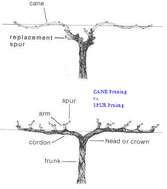Pruning
If you live around vineyards you may have noticed that all the vines look like they’ve been getting haircuts. Just as things have finally slowed down enough for everyone to catch their breath, the time for preparing for the next growing season has come. Since pruning is what’s on every vineyard manager’s mind right now, I thought I would share with you what exactly we’re doing out there.
When vines are pruned, the growth from the last season is cut off except for a select bit which will determine where the vine will grow from this coming season. This keeps the vines in balance, creating the desired amount of fruit, and eases canopy management. Well-pruned vines will be healthier and less likely to develop problems like powdery mildew during the growing season.
The two most common types of pruning in Sonoma and Napa counties are Cane and Cordon. Each has different benefits and drawbacks, and the decision about which to use depends largely on location and management style. In the photo below, the vine on top has been cane pruned, and the vine on the bottom, cordon.
When vines are pruned, the growth from the last season is cut off except for a select bit which will determine where the vine will grow from this coming season. This keeps the vines in balance, creating the desired amount of fruit, and eases canopy management. Well-pruned vines will be healthier and less likely to develop problems like powdery mildew during the growing season.
The two most common types of pruning in Sonoma and Napa counties are Cane and Cordon. Each has different benefits and drawbacks, and the decision about which to use depends largely on location and management style. In the photo below, the vine on top has been cane pruned, and the vine on the bottom, cordon.
Cane takes two (usually, but sometimes up to four!) of the shoots from the last season and lays them down the fruit wire, while cutting everything else off. The dormant buds on these canes will grow and bear fruit for the next season. When the time comes to prune once again, everything will be cut off except for two replacement canes which will be retied to the fruit wire, replacing the ones you just cut off. Cordon, you’ll notice, has thicker arms coming off the trunk. This is because this method of pruning starts the same way, laying down a shoot from the last year along the fruit wire and growing the fruit-bearing shoots from there. The only difference is you don’t cut off the shoots you laid along the fruit wire the season before when it comes time to prune again; instead you cut the shoots that grew from it and bore fruit that season down to short spurs. These spurs will have the buds that will grow for the next season and will bear the fruit.
Cane pruning is often preferred for cooler, coastal vineyards, such as our Hillcrest estate vineyard. This is because the buds further along the cane developed later in the season with better sunlight, and will usually produce more fruit, helping to offset the usually lower yields of costal vineyards. Cordon, on the other hand, only makes use of the first two or so buds on each cane, therefore usually producing less fruit.
Pruning is hard work, especially with this beautiful weather we’ve been having. So if you know anyone working on a pruning crew, or any vineyard managers tearing their hair out trying to get all the pruning done in time, buy them a drink this weekend and remind them to take it easy!



